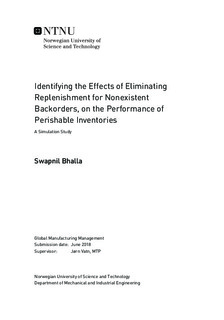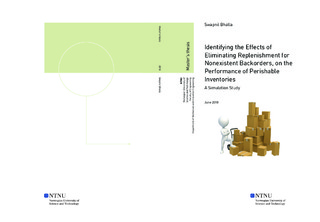| dc.description.abstract | Inventory control is an indispensable activity in operations management. Variability and uncertainty of demand increase the complexity of inventory control activities. The complexity further amplifies when the inventories to be controlled are of perishable products, such as fresh fruits and vegetables, dairy products, meat, blood, chemicals, etc. Such products have limited usable lifetimes and are discarded if not used within this period. For food products, the discarded items amount to food wastes, which are associated with negative social, environmental and economic impacts.
In case of unavailability of products that are of general use rather than special occasion use, such as milk, customers find alternative products or buy the products elsewhere; but are seldom found postponing the purchase of such products, and buying them later at the same store. As a result, in cases of unavailability of such products, sales are lost and the phenomenon of backordering diminishes.
Majority of inventory replenishment models in classical inventory theory, are based on the assumption of backordering. If replenishment is done assuming that customers will return to fulfil their demand, while actual customer behaviour contradicts the expected behaviour; the assumption becomes the cause of over-ordering, as inventory is held in anticipation of demand that has already been lost.
This issue was observed in policies which are intended to cater to replenishment of perishables in grocery retail. These policies exhibit an underlying assumption of backordering, due to having their roots in classical inventory theory. When the inventoried product under consideration is perishable, over-ordering and holding excess inventory, can become a cause of waste. However, reducing order sizes can also be expected to fulfil lower proportions of demand, thus, lowering profits and availability. As a result, the objective of this research was to identify the simultaneous effects of eliminating the backordering assumption, on various inventory performance measures and answering the question:
How are the performance indicators: waste, fill rate, inventory level and number of deliveries; for perishable inventories with no backorders, affected when lost-sales are taken into account while ordering?
To answer the question, a simulation study was conducted on a model that was developed to represent the characteristics of a milk inventory in grocery retail store; where modified and unmodified forms of three ordering policies were compared. The unmodified forms reflected a backordering assumption. The modified forms excluded replenishment for demand that would be lost by the time the order arrives.
The study showed that the proposed modifications reduce waste for stores that experience waste under the unmodified policy. However, the percentage reduction varies with the store characteristics of weekly demand and review intervals. Stores with high weekly demands and low review intervals were found relatively immune to wastes under the unmodified policy, and have little value for such modifications. Among the stores with low weekly demands and high review intervals, the policy modification was observed to have varying level of impact on waste and availability. To summarise the measure of impact, the ratio of change in overstocking and change in understocking was used; where overstocking was represented by the percentage of items that were wasted out of those purchased; and understocking was represented by the percentage of demand that was fulfilled. This measure was referred to as the value of policy change, and was plotted for various store characteristics; for product characteristics that represented milk; and additionally for three other set of characteristics to assess the sensitivity towards these characteristics.
The policy modification can be concluded to have varying levels of value for different stores that face wastes under the unmodified policy forms, and the number of these stores varies with product characteristics. The value of policy modification is higher, for products with shelf lives lower than milk, if customer responses to stock-outs of these products reflect no or minimal backordering. | |

